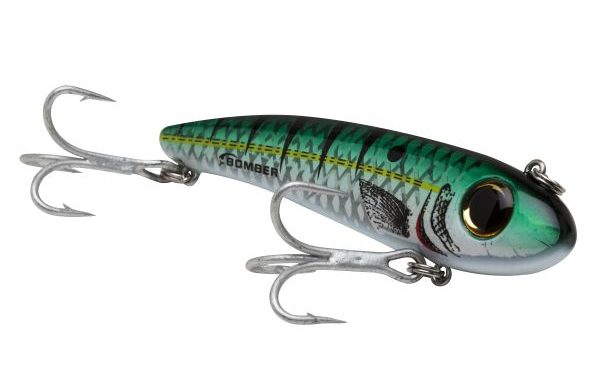
Give Theophile Bourgeois a new artificial lure with so much upside to it and he’s as happy as speckled trout and redfish chasing tasty mullet.
The Bomber artificial lure manufacturing company made him and the anglers who fish with Barataria-based Bourgeois Fishing Charters extremely happy when it introduced the Bomber Saltwater Grade Mullet, a suspending hard bait armed with “stout hooks” that can handle speckled trout of any size as well as the biggest, meanest redfish, which Bourgeois referred to as “pit bulls.”
The 20-year veteran charter boat captain said it is ideal for retrieving over sand and is a killer when worked slowly and erratically over grass.
“It does really well,” Bourgeois said. “It catches fish. It’s a good bait for someone who’s getting into that style of fishing. Even on the fall, slowly sinking, it’ll catch fish because it’s always moving. Everything about it is plus, plus, plus.
“Trout hate it, meaning they love it. When you’re in a school of trout, a lot of times you’ll get bigger fish,” he said.
Bomber began shipping the new artificial lures in mid-February 2014, according to Bomber saltwater brands manager Russell Garner. Garner worked 30 years in the company’s Fort Smith, Ark., office before moving to where he would be closer to the saltwater fishing action.
“It’s doing all right. We’re just really kind of getting it going with the marketing,” Garner said.
For the record, the Bomber Saltwater Grade Mullet is 3 ½ inches long and weighs five-eighths of an ounce. The new artificial lure comes in nine color patterns.
It is catching fish in coastal waters and beyond from Texas to South Carolina, he said. Speckled trout, redfish, stripers, snook and even Spanish mackerel — as well as other species — are falling for the slow sinker.
If you think you’ve seen the artificial lure before, you probably have. It has been reintroduced after being off the market for a few decades.
“The Mullet is a bait we had back in the late ’80s, ’90s,” Garner said. “There were two sizes that we had — a floater and the suspender. It’s a bait that did really well back then.”
Interest waned some as other artificial lures hit the market and took their turn in the limelight. Artificial lure manufacturers turned their attention to those, and the Mullet was retired.
Still, some anglers continued to rely on the Mullet. And in the late 2000s word got to management that it was time to bring back the Mullet.
Among the people who let Garner know was a “guy in the office” who told Garner that he would like to see a return of the Mullet. The Bomber saltwater brands manager and others listened.
“It was just a matter of getting to it with all the saltwater and freshwater brands we have,” Garner said. “It gives us another sinking-type bait, a different shape. So far it’s been well-received.”
The new model’s beginning was four or five years ago. A prototype eventually was sent to Bourgeois, the veteran saltwater fishing guide in Barataria. He liked what he saw and he loved the immediate results.
He tried it out in the ultra-clear saltwater around Breton Sound. The prototype was little more than a chunk of nicely shaped artificial lure minus the vibrant color combinations it has today.
“Overall, it’s very productive. You work it just as you do a topwater walk-the-dog, only underwater,” he said.
There is the visual attraction as well as an audible appeal because the Bomber Saltwater Grade Mullet has a rattle chamber.
“It has a little click. Not all suspending baits have it,” Bourgeois said.
He has seen speckled trout 10 feet away from the artificial lure turn and swim to it with ill intentions, said the angler whose biggest speckled trout of his career is a 7 ½-pounder.
The key to fishing with the Bomber Saltwater Grade Mullet is to know how fast it sinks. To do that, Bourgeois recommended letting 2 feet or so of slack in the line and dropping it in the water. With the rod rip at the surface, count one, two, three and so on until the line tightens — that tells you how many seconds it takes to get to that depth.
Adjust accordingly, he said, especially over grass 1 to 1 ½ feet under the surface.
Also, to avoid getting the treble hooks caught up in the 30-pound fluorocarbon leader he uses, touch the line with your finger on a cast just before the artificial lure hits the water to put some tension on the line and lay the bait out so it is “100 percent ready,” he said.
Bourgeois said he does that each time, without fail, with any artificial lure he’s casting.
For more information, call 479-414-8765 or go to www.bombersaltwatergrade.com.


